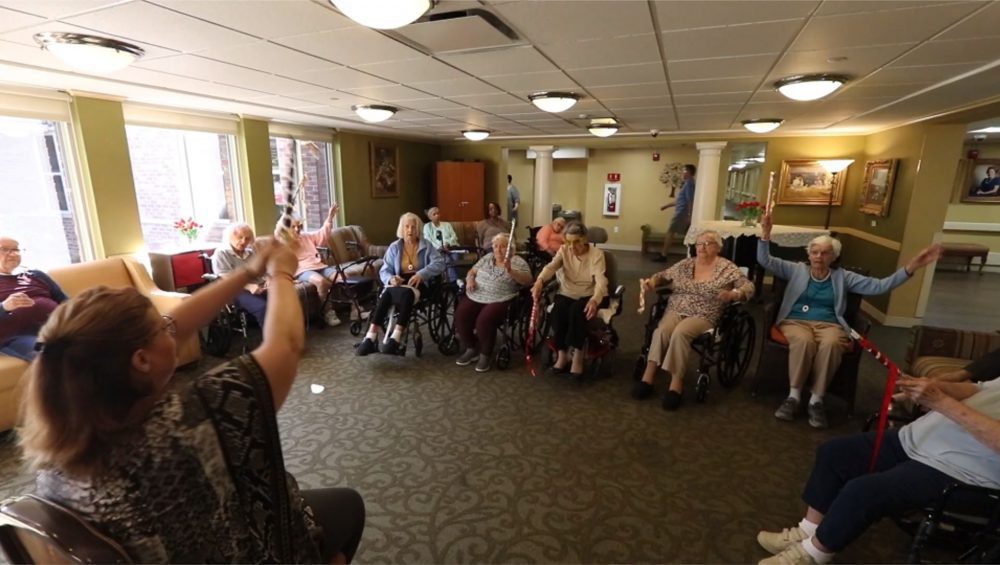Exercise is important for everyone, but especially for seniors who want to maintain their health, mobility, and independence. However, some seniors may have difficulty or discomfort with standing or walking exercises, due to pain, injury, or balance issues. That’s why chair exercises are a great option for seniors who want to stay fit and active without putting too much strain on their joints and muscles.
Chair exercises are exercises that can be done while sitting on a chair or using a chair for support. They can help improve your strength, flexibility, endurance, and coordination. They can also help prevent or manage various health conditions, such as arthritis, diabetes, osteoporosis, or heart disease. Chair exercises can also boost your mood and energy levels, as well as your confidence and self-esteem.
Here are some easy and impactful chair exercises for seniors that you can try at home or in a group setting. You will need a sturdy chair with a backrest and no wheels, and some optional equipment, such as a pair of light dumbbells, a resistance band, or a ball. You should also wear comfortable clothes and shoes, and have a bottle of water nearby. You should consult your doctor before starting any exercise program and listen to your body’s signals. You should stop if you feel any pain, dizziness, or shortness of breath.
- Warm-up. You should always start with a warm-up to prepare your body and mind for the exercise. You can do some gentle movements, such as shoulder rolls, neck rotations, arm circles, ankle circles, or toe taps. You can also do some breathing exercises, such as inhaling through your nose and exhaling through your mouth. You should aim for 5 to 10 minutes of warm-up.
- Upper body exercises. These exercises can help strengthen your arms, shoulders, chest, and back. You can use dumbbells, resistance bands, or your own body weight as resistance. Some examples of upper body exercises are:
- Bicep curls. Hold a dumbbell in each hand and rest your arms on the sides of the chair. Keep your elbows close to your body and your palms facing up. Slowly curl your arms up toward your shoulders, then lower them back to the starting position. Repeat 10 to 15 times.
- Chest press. Hold a dumbbell in each hand and bring your arms up to the sides of your chest. Keep your elbows bent at 90 degrees and your palms facing forward. Slowly press your arms forward until they are fully extended, then bring them back to the starting position. Repeat 10 to 15 times.
- Rowing. Hold a resistance band in both hands and wrap it around the back of the chair. Sit up straight and keep your arms extended in front of you. Slowly pull the band toward your chest, squeezing your shoulder blades together. Then slowly extend your arms back to the starting position. Repeat 10 to 15 times.
- Lower body exercises. These exercises can help strengthen your legs, hips, and glutes. You can use dumbbells, resistance bands, or your own body weight as resistance. Some examples of lower body exercises are:
- Leg extensions. Sit up straight and keep your feet flat on the floor. Hold a dumbbell on each thigh if you want to add some weight. Slowly extend one leg until it is parallel to the floor, then lower it back to the starting position. Repeat 10 to 15 times with each leg.
- Hip abduction. Sit up straight and keep your feet together on the floor. Wrap a resistance band around both ankles if you want to add some resistance. Slowly move one leg out to the side as far as you can, then bring it back to the starting position. Repeat 10 to 15 times with each leg.
- Squats. Stand up from the chair and keep your feet shoulder-width apart. Hold onto the back of the chair for support if you need it. Slowly bend your knees and lower your hips until you are almost sitting on the chair, then stand up again. Repeat 10 to 15 times.
- Core exercises. These exercises can help strengthen your abdominal and back muscles, which support your posture and balance. You can use a ball or your own body weight as resistance. Some examples of core exercises are:
- Seated crunches. Sit up straight and hold a ball in front of you with both hands. Keep your feet flat on the floor and your knees bent at 90 degrees. Slowly lean back until you feel a slight tension in your abs, then curl forward until you touch the ball to your knees. Repeat 10 to 15 times.
- Twists. Sit up straight and hold a ball in front of you with both hands. Keep your feet flat on the floor and your knees bent at 90 degrees. Slowly twist your torso to one side, then to the other side, keeping the ball in front of you. Repeat 10 to 15 times on each side.
- Back extensions. Sit up straight and place your hands behind your head. Keep your feet flat on the floor and your knees bent at 90 degrees. Slowly arch your back and look up at the ceiling, then return to the starting position. Repeat 10 to 15 times.
- Cool-down. You should always end with a cool-down to relax your body and mind after the exercise. You can do some gentle stretches, such as chest stretch, shoulder stretch, neck stretch, hamstring stretch, or calf stretch. You can also do some breathing exercises, such as inhaling through your nose and exhaling through your mouth. You should aim for 5 to 10 minutes of cool-down.
These are some easy and impactful chair exercises for seniors that you can try at home or in a group setting. By doing these exercises regularly, you can improve your heart health, muscle strength, joint flexibility, and overall well-being. You can also have fun and enjoy the benefits of physical activity.





